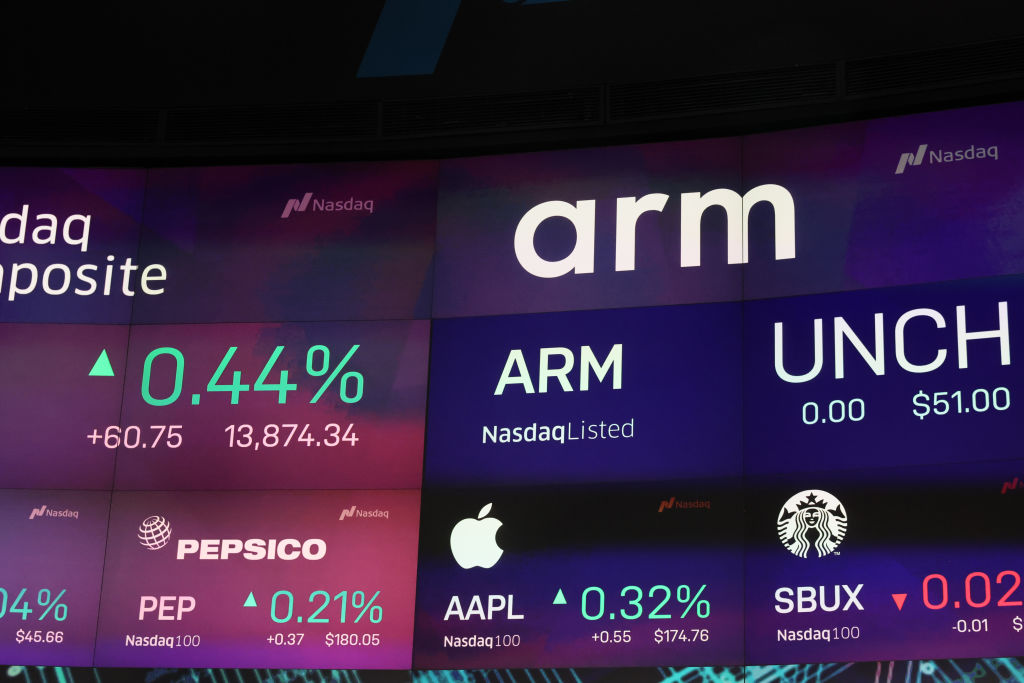Arm Stock Sinks as Soft Outlook Offsets AI-Fueled Earnings Beat
Arm Holdings stock is deep in the red Thursday after the chipmaker's full-year outlook fell short of Wall Street's expectations. Here's what you need to know.


Arm Holdings (ARM) stock is down plunging Thursday as the chipmaker's weak guidance offsets a fiscal first-quarter top- and bottom-line beat.
In the three months ended June 30, Arm's revenue increased 39.1% year-over-year to $939 million. Its earnings per share (EPS) rose 66.7% from the year-ago period to 40 cents.
"Artificial intelligence (AI) demand and rising compute subsystems (CSS) adoption across major market segments drove record revenue," said Arm CEO Rene Haas in a statement. "As the energy needs of AI continue to escalate, so does the demand for the high-performance, power-efficient Arm compute platform."
From just $107.88 $24.99 for Kiplinger Personal Finance
Become a smarter, better informed investor. Subscribe from just $107.88 $24.99, plus get up to 4 Special Issues

Sign up for Kiplinger’s Free Newsletters
Profit and prosper with the best of expert advice on investing, taxes, retirement, personal finance and more - straight to your e-mail.
Profit and prosper with the best of expert advice - straight to your e-mail.
The company's results handily beat analysts' expectations. Wall Street was anticipating revenue of $902.7 million and earnings of 34 cents per share, according to CNBC.
However, sentiment turned negative toward the semiconductor stock when Arm reiterated its full-year outlook, calling for revenue in the range of $3.8 billion to $4.1 billion and EPS in the range of $1.45 to $1.65. The midpoint of these ranges, $3.95 billion in revenue and earnings of $1.55 per share, is short of analysts' expectations of $4 billion in revenue and earnings of $1.58 per share.
Arm also provided an outlook for its fiscal second quarter. The chipmaker anticipates revenue to arrive between $780 million to $830 million and earnings per share in the range of 23 cents to 27 cents. The midpoint of these ranges, $805 million in revenue and earnings of 25 cents per share, are mixed versus the $804.1 million in revenue and earnings of 27 cents per share that Wall Street is anticipating.
In an update to its reporting process, the company announced that it will no longer disclose the number of Arm-based chips reported as shipped.
"We previously considered the number of chips reported as shipped by our customers as a key performance indicator because it represented the acceptance of our products by companies who use chips in their products," Arm said. "As we shift our focus to higher-value, lower-volume markets such as data center servers, AI accelerators and smartphone applications processors, the number of chips reported as shipped is less representative of our performance as the growth in royalty revenue is concentrated in a smaller number of chips."
Is Arm Holdings stock a buy, sell or hold?
Arm Holdings has been one of the best stocks on the price charts this year, up more than 60%. And Wall Street is generally bullish toward the chipmaker, which went public in September 2023 in one of the biggest IPOs in U.S. history.
According to S&P Global Market Intelligence, the average analyst target price for ARM stock is $129.81, representing implied upside of about 6% to current levels. Meanwhile, the consensus recommendation on the tech stock is Buy.
But some analysts think the stock is pricey after its run higher. Financial services firm Needham, for instance, has a Hold rating on ARM because of its valuation.
While the company reported solid first-quarter results, this was the first print in which it did not raise its outlook, Needham analyst Charles Shi said in a note this morning. "The lack of upside could be seen as a negative for the stock that trades at a sky-high valuation."
So despite Arm being "a solid business with great growth potential, we remain on the sidelines based on valuation," Shi concluded.
Related Content
Profit and prosper with the best of Kiplinger's advice on investing, taxes, retirement, personal finance and much more. Delivered daily. Enter your email in the box and click Sign Me Up.

Joey Solitro is a freelance financial journalist at Kiplinger with more than a decade of experience. A longtime equity analyst, Joey has covered a range of industries for media outlets including The Motley Fool, Seeking Alpha, Market Realist, and TipRanks. Joey holds a bachelor's degree in business administration.
-
 Stocks Struggle Ahead of November Jobs Report: Stock Market Today
Stocks Struggle Ahead of November Jobs Report: Stock Market TodayOracle and Broadcom continued to fall, while market participants looked ahead to Tuesday's jobs report.
-
 7 Dr. Seuss Quotes Retirees Should Live By
7 Dr. Seuss Quotes Retirees Should Live ByYou're off to great places! Why Dr. Seuss is the retirement guru you didn't know you needed.
-
 Fed's Rate Cuts Could Have Impacts You Might Not Anticipate
Fed's Rate Cuts Could Have Impacts You Might Not AnticipateUnderstanding how lower interest rates could impact your wallet can help you determine the right financial moves to make.
-
 Stocks Struggle Ahead of November Jobs Report: Stock Market Today
Stocks Struggle Ahead of November Jobs Report: Stock Market TodayOracle and Broadcom continued to fall, while market participants looked ahead to Tuesday's jobs report.
-
 Past Performance Is Not Indicative of Your Financial Adviser's Expertise
Past Performance Is Not Indicative of Your Financial Adviser's ExpertiseMany people find a financial adviser by searching online or asking for referrals from friends or family. This can actually end up costing you big-time.
-
 I'm a Financial Planner: If You're Not Doing Roth Conversions, You Need to Read This
I'm a Financial Planner: If You're Not Doing Roth Conversions, You Need to Read ThisRoth conversions and other Roth strategies can be complex, but don't dismiss these tax planning tools outright. They could really work for you and your heirs.
-
 Could Traditional Retirement Expectations Be Killing Us? A Retirement Psychologist Makes the Case
Could Traditional Retirement Expectations Be Killing Us? A Retirement Psychologist Makes the CaseA retirement psychologist makes the case: A fulfilling retirement begins with a blueprint for living, rather than simply the accumulation of a large nest egg.
-
 I'm a Financial Adviser: This Is How You Can Adapt to Social Security Uncertainty
I'm a Financial Adviser: This Is How You Can Adapt to Social Security UncertaintyRather than letting the unknowns make you anxious, focus on building a flexible income strategy that can adapt to possible future Social Security changes.
-
 I'm a Financial Planner for Millionaires: Here's How to Give Your Kids Cash Gifts Without Triggering IRS Paperwork
I'm a Financial Planner for Millionaires: Here's How to Give Your Kids Cash Gifts Without Triggering IRS PaperworkMost people can gift large sums without paying tax or filing a return, especially by structuring gifts across two tax years or splitting gifts with a spouse.
-
 'Boomer Candy' Investments Might Seem Sweet, But They Can Have a Sour Aftertaste
'Boomer Candy' Investments Might Seem Sweet, But They Can Have a Sour AftertasteProducts such as index annuities, structured notes and buffered ETFs might seem appealing, but sometimes they can rob you of flexibility and trap your capital.
-
 AI Stocks Lead Nasdaq's 398-Point Nosedive: Stock Market Today
AI Stocks Lead Nasdaq's 398-Point Nosedive: Stock Market TodayThe major stock market indexes do not yet reflect the bullish tendencies of sector rotation and broadening participation.